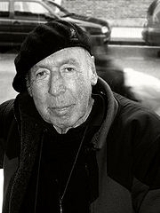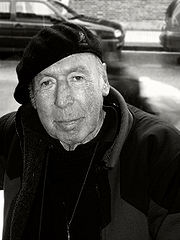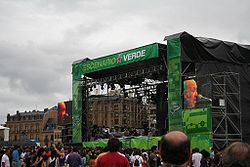
Mikel Laboa
Encyclopedia

Pasaia
Pasaia is a town and municipality located in the province of Gipuzkoa in the Basque Autonomous Community of northern Spain. It is a fishing community, commercial port and the birth place of the fighting admiral Blas de Lezo. Pasaia lies approximately 5 km east of Donostia's centre, lying at the...
, 15 June 1934 – Donostia-San Sebastián
San Sebastián
Donostia-San Sebastián is a city and municipality located in the north of Spain, in the coast of the Bay of Biscay and 20 km away from the French border. The city is the capital of Gipuzkoa, in the autonomous community of the Basque Country. The municipality’s population is 186,122 , and its...
, 1 December 2008) was one of the Basque Country's most important singer-songwriter
Singer-songwriter
Singer-songwriters are musicians who write, compose and sing their own musical material including lyrics and melodies. As opposed to contemporary popular music singers who write their own songs, the term singer-songwriter describes a distinct form of artistry, closely associated with the...
s.
Considered the patriarch of Basque music, his music has had an influence on younger generations. A testament to this is the tribute album Txerokee, Mikel Laboaren Kantak ("Cherokee: Songs of Mikel Laboa"), published in 1991 by various younger-generation rock
Rock music
Rock music is a genre of popular music that developed during and after the 1960s, particularly in the United Kingdom and the United States. It has its roots in 1940s and 1950s rock and roll, itself heavily influenced by rhythm and blues and country music...
and folk music
Folk music
Folk music is an English term encompassing both traditional folk music and contemporary folk music. The term originated in the 19th century. Traditional folk music has been defined in several ways: as music transmitted by mouth, as music of the lower classes, and as music with unknown composers....
groups. His album Bat-Hiru ("One-Three") was chosen in a reader poll by the local Diario Vasco newspaper as the greatest Basque album in history. Nearly all of his songs are sung in Basque
Basque language
Basque is the ancestral language of the Basque people, who inhabit the Basque Country, a region spanning an area in northeastern Spain and southwestern France. It is spoken by 25.7% of Basques in all territories...
.
Biography
Mikel Laboa was born June 15, 1934 in PasaiaPasaia
Pasaia is a town and municipality located in the province of Gipuzkoa in the Basque Autonomous Community of northern Spain. It is a fishing community, commercial port and the birth place of the fighting admiral Blas de Lezo. Pasaia lies approximately 5 km east of Donostia's centre, lying at the...
, Gipuzkoa.
He spent nearly two years of his childhood in the town of Lekeitio
Lekeitio
Lekeitio is a town and municipality located in the province of Biscay, in the Spanish Autonomous Community of Basque Country, 53 km northeast from Bilbao. The municipality has 7,293 inhabitants and is one of the most important fishing ports of the Basque coast...
, Bizkaia. In the 1950s he studied medicine
Medicine
Medicine is the science and art of healing. It encompasses a variety of health care practices evolved to maintain and restore health by the prevention and treatment of illness....
and psychiatry
Psychiatry
Psychiatry is the medical specialty devoted to the study and treatment of mental disorders. These mental disorders include various affective, behavioural, cognitive and perceptual abnormalities...
in Pamplona-Iruña
Pamplona
Pamplona is the historial capital city of Navarre, in Spain, and of the former kingdom of Navarre.The city is famous worldwide for the San Fermín festival, from July 6 to 14, in which the running of the bulls is one of the main attractions...
. He would constantly balance his artistic career with his medical career, which began at the Children's Neuropsychiatry unit at Patronato San Miguel in San Sebastián, where he worked for almost 20 years.
During his student years he became interested in music, influenced by artists such as Atahualpa Yupanqui
Atahualpa Yupanqui
Atahualpa Yupanqui was an Argentine singer, songwriter, guitarist, and writer. He is considered the most important Argentine folk musician of the 20th century....
and Violeta Parra
Violeta Parra
Violeta del Carmen Parra Sandoval was a notable Chilean composer, songwriter, folklorist, ethnomusicologist and visual artist...
. Following in their footsteps, Laboa would likewise identify himself as a "political artist." In 1958 he made his debut at the Teatro Gayarre in Pamplona.
During the 1960s he, along with other Basque artists, founded the cultural group Ez Dok Amairu ("There is no 13"), which in many ways sought to revitalize Basque culture, long dormant under the Francoist regime. They dedicated their focus on the revival and social status of the Basque language. Within this group Laboa came into his own, emerging along with Benito Lertxundi
Benito Lertxundi
Benito Lertxundi is a Basque singer-songwriter born in Orio in 1942 . He is an acclaimed and veteran figure in Basque music, who spearheaded with other key figures its revival in the 1960s and following years, showing an especial commitment to Basque culture and matters in general.-Discography:*...
as a prime example of what was called "new Basque music."
Laboa's music can be described as a combination of tradition, poetry and experimentalism, in the songwriting style of the 1960s and 1970s, but endowed with a strong personal touch and a unique voice. His work combines old standards reinterpreted in modern style, lyrical poetry from authors such as Bertolt Brecht
Bertolt Brecht
Bertolt Brecht was a German poet, playwright, and theatre director.An influential theatre practitioner of the 20th century, Brecht made equally significant contributions to dramaturgy and theatrical production, the latter particularly through the seismic impact of the tours undertaken by the...
, and suitable compositions. Deserving special mention are his Lekeitioak, experimental songs based on shouts and onomatopoetic sounds, which long predated the sounds of Bjork
Björk
Björk Guðmundsdóttir , known as Björk , is an Icelandic singer-songwriter. Her eclectic musical style has achieved popular acknowledgement and popularity within many musical genres, such as rock, jazz, electronic dance music, classical and folk...
and other vanguard musicians of today.
His album Bat-Hiru from 1974 was named "Best Album in History" in a reader poll by the Diario Vasco a few years ago. Some of his songs have already become popular classics in Basque folk music, especially Txoria txori ("A bird is a bird"), his most famous song, of which Joan Baez
Joan Baez
Joan Chandos Baez is an American folk singer, songwriter, musician and a prominent activist in the fields of human rights, peace and environmental justice....
did an interpretation using the original Basque
Basque language
Basque is the ancestral language of the Basque people, who inhabit the Basque Country, a region spanning an area in northeastern Spain and southwestern France. It is spoken by 25.7% of Basques in all territories...
lyrics. There is also an orchestral version of the song, in collaboration with the Orfeón Donostiarra (Donostia Choir) credited as the Joven Orquesta de Euskal Herria (Euskal Herriko Gazte Orkestra or "Young Orchestra of the Basque Country"). Other prominent songs include Gure Hitzak ("Our words"), Haika mutil and Baga, biga, higa (also in collaboration with the Orfeón Donostiarra).

La pelota vasca
La pelota vasca: la piel contra la piedra is a 2003 documentary film written and directed by Spanish filmmaker Julio Médem.-Overview:The film's purported intention is to create a bridge between the different political positions that coexist, sometimes violently, in the Basque Country...
("The Basque ball"), a documentary by Julio Medem
Julio Medem
Julio Médem is a Spanish writer and film director.Medem was born in San Sebastián, Basque Country, Spain and showed an interest in movies since childhood, when he would take his father's Super 8 camera and shoot at night, while nobody was paying attention...
. On July 11, 2006 he gave his final performance, opening for Bob Dylan
Bob Dylan
Bob Dylan is an American singer-songwriter, musician, poet, film director and painter. He has been a major and profoundly influential figure in popular music and culture for five decades. Much of his most celebrated work dates from the 1960s when he was an informal chronicler and a seemingly...
at a "Concert for Peace" held in the city of Donostia-San Sebastián
San Sebastián
Donostia-San Sebastián is a city and municipality located in the north of Spain, in the coast of the Bay of Biscay and 20 km away from the French border. The city is the capital of Gipuzkoa, in the autonomous community of the Basque Country. The municipality’s population is 186,122 , and its...
.
A curious feature of his album titles is the fact that they are numeric. This custom began in 1974 with the release of his two-disc Bat-Hiru (1-3). The album 2, with songs based on the writings of Brecht, had been banned by Francoist censorship
Censorship
thumb|[[Book burning]] following the [[1973 Chilean coup d'état|1973 coup]] that installed the [[Military government of Chile |Pinochet regime]] in Chile...
. This was followed by the double LP Lau-Bost (4-5) and 6. His Lekeitios comprised albums 7 through 11, although only a compilation of these was released through low-key marketing. These were followed by 12, and Laboa skipped number 13 in homage to the group Ez Dok Amairu, whose name means "There's no 13" in Basque. Afterwards, he released 14, and his live albums 15 and 16. Not including compilations, his most recent release was 17 (Xoriek).
His final collaboration was with the Pasaia
Pasaia
Pasaia is a town and municipality located in the province of Gipuzkoa in the Basque Autonomous Community of northern Spain. It is a fishing community, commercial port and the birth place of the fighting admiral Blas de Lezo. Pasaia lies approximately 5 km east of Donostia's centre, lying at the...
group Naizroxa, where he contributed to the first and only song on the first disc, "Iqharaturic."
Mikel Laboa died December 1, 2008 at a hospital in Donostia-San Sebastián
San Sebastián
Donostia-San Sebastián is a city and municipality located in the north of Spain, in the coast of the Bay of Biscay and 20 km away from the French border. The city is the capital of Gipuzkoa, in the autonomous community of the Basque Country. The municipality’s population is 186,122 , and its...
at the age of 74.
Discography
- Lau herri kanta, 1964
- Ursuako Kantak, 1966
- Bertold Brecht, 1969
- Haika Mutil, 1969
- Euskal Kanta Berria, 1972
- Bat-Hiru, 1974
- Lau-bost, 1980
- 6 (Sei), 1985
- Lekeitioak, 1988
- 12 (Hamabi), 1989
- 14 (Hamalau), 1994
- Mikel Laboa Zuzenean, 1997
- Zuzenean II - Gernika, 2000
- 60ak+2, 2003
- Xoriek - 17, 2005

